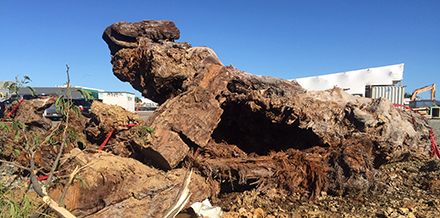
A cache of swamp kauri found by construction workers earlier this year on the West Auckland building site of the country’s largest retail store may yield important information about climate change according to a leading environmental scientist. Source: Timberbiz
Results from radiocarbon dating carried out by scientists from NIWA, the National Institute of Water and Atmospheric Research and the University of Waikato Radiocarbon Dating Laboratory indicate the swamp kauri discovered at the site of the Nido furniture store is more than 45,000 years old – placing it within the Paleolithic age of human prehistory.
According to NIWA’s principal scientist Dr Andrew Lorrey, data gained from the unearthed wood could have considerable significance internationally. He says that due to the sensitivity of kauri to regional climate patterns, important knowledge could be gained on how El Niño operated in the past and how it might change in the future.
“I thought initially it was going to be less than 10,000 years in terms of radiocarbon dating but we now have enough certainty to establish a radiocarbon date of more than 45,000. That much older than we expected. It is rare to find a site where all the wood has the same date, so more work on the Nido wood is still required,” Dr Lorrey said.
The ancient wood was discovered at a depth of four metres and assistant site manager Lisa Wade identified the significance of the find straight away.
The swamp kauri was sealed off underground which has kept the timber preserved in exceptional condition but as the wood was saturated, the scientists need to let it dry for some time before they can investigate further.
“Once it’s dry enough, we take it back to the lab and sand it down, so that we can see the rings clearly and measure the sequences. It’s like a time barcode.
“We’ll then run those barcode sequences against other reference chronologies that have already been dated and see if we get a match. It will be interesting to see when these trees were growing, and if it tells us something about when a kauri forest may have been present there,” Dr Lorrey said.
It is hard to know precisely what they are dealing with until they measure it and try to match the ring patterns against other trees that have a close radiocarbon date. But because kauri tree rings are annual, it’s like a high-resolution time capsule. If the swamp kauri is as ancient and unique as now believed, more significant information can be retrieved from its discovery.
“That time period was characterised by rapid climate changes, most probably caused by the Northern Hemisphere ice sheets and sea level fluctuating wildly. We think that by looking closely at these trees, we can learn something new about the global climate system, “When we get all the data together on the same timescale, we’ll get an interesting picture of climate and environmental changes on the planet,” Dr Lorrey said.
“Kauri contains patterns that appear sensitive to that particular climate mode, which has a strong impact on New Zealand. From examining El Niño’s behaviour back in time, this wood could be a hugely valuable tool. It can help us examine periods of El Niño activity during the times when humans weren’t around in the landscape to modify it.
“We can get a good picture of what’s going on with this major climate mode, which impacts billions of people all over the world. It also gives us an idea about the range of natural climate variations that impact on New Zealand, which is important for planning future climate extremes.”
The swamp kauri found at the site has been gifted to traditional Māori carvers.





